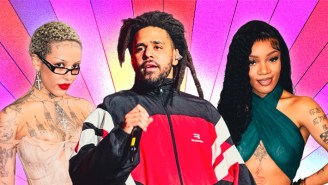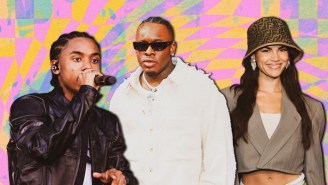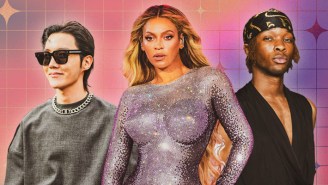This summer, Tyler the Creator took a pretty significant step in fashion; the rapper held his first-ever fashion show for his brand Golf Wang. The event was a bit of a stake in the sand, demonstrating how the venture wasn’t simply concert merchandise but instead was just one part of an expansive lifestyle. But even if it was a remarkable jump, the Los Angeles based presentation wasn’t unprecedented in the hip-hop arena.
Most neatly, hip hop’s relationship with the fashion industry in a mutually beneficial way can be traced back to Run DMC’s link up with Adidas. The group’s music video “My Adidas” featured dookie chains, tracksuits and shelltoe sneakers and eventually led to Run DMC’s own endorsement deal with the sportswear company. Adidas got the exposure, the influence to a hip-hop audience (but also took on this new, emerging idea of cool) while the rappers got the cold hard cash in the form of an unprecedented $1 million deal. But out of it sprouted a new market; “urban wear” and the consumers who buy it.
https://www.instagram.com/p/BMzo2kcAdEv/
The fashion industry doesn’t really talk about urban wear anymore — it’s place in the industry has arguably been replaced by streetwear –but in the ’90s and early aughts, it was all the rave. In 2001, Sean John made waves when it produced a $1 million fashion show in New York replete with what some called the first nationally live televised fashion show. That was only three years into the founding of the company and was followed up a year later with another blowout show with a budget of $1.24 million. And it was needed: At the time, founder Sean Combs was elbowing his way into a market that already contained brands like Russell Simmons’ Phat Farm and Baby Phat which had been around since the early ’90s, and more.
At the time, urban wear had a typical approach. It was oversized and sort of braggadocios. Take Sean John with its oversized fur coats on the runway and the baggy jeans. Even down to the labels; this was a point in time where who you were wearing was important as how it looked. It was the time of Aaliyah being in head to toe Tommy Hilfiger, with a logo-ed bandeau and waistband. Sure Tommy Hilfiger wasn’t an urban wear brand in its founding, but it undeniably became a part of the aesthetic. It was an aesthetic that revolved around a sort of exaggeration. Of proportions, of tastes. Everything needed to be bigger and it was in that sense it was better.
Take Phat Farm. The distinguishing factor for it among its contemporaries was that it incorporated a sense of prep. They’d play with that element by taking plaid, a fabric associated strongly with Ivy League schools, and doing an oversized hoodie completely in that print, or using an argyle print and enlarging it for the main motif on an oversized sweater vest or just on a t-shirt. In this way, urban wear was a reaction to mainstream styles, taking what the mainstream considered to be stylish and fashionable and putting a twist on it, taking it to the Nth degree in cases like that of Dapper Dan who took the mainstream fascination with logos and blew it out of proportion.
Founded in 2011, Tyler the Creator’s brand follows along these lines. It takes the idealized tropes of the mainstream and co-opts them. The longest running trope involves golf wear and the pomp and the preppy aesthetic surrounding that but over the years the company has gotten into other things.
Ostensibly, urban wear was about making a statement. Essentially, it was the first time that a group of black designers (as opposed to a few outliers) saw mainstream success. As such, the statement was typically, “we don’t need your brands,” as in the case of FUBU which was an acronym for the “For Us By Us” movement many of these brands fell into. But sometimes the statement was “we do you, better than you,” as in the case of hip-hop stars co-opting mainstream brands and restyling them into their own looks or even just copying the designs in new ways. Golf Wang follows in the legacy.
Most directly, Golf Wang has made statements of a political nature. There was a much discussed “Adolf Trump” shirt which featured Donald Trump’s portrait treated with an Adolf Hitler-esque mustache. The piece was eerily prophetic with the words above saying “President of the United States” and the words below saying “We Fucked Up.” But that’s not all of course; in a bit of an inclusive design Tyler flipped neo-nazi imagery on its head. Taking a logo that he found being used by a group called “White Pride Worldwide” the artist rendered it in a rainbow and surrounded it with the words “Golf Pride World Wide.” For social media imagery, he even appeared hand in hand with another guy. It was quite the statement.
But it’s more than that. Like streetwear brands past, Golf Wang takes something from the “mainstream,” something as stuffy as golf wear and brings it into the consciousness of a new demographic. That could be as simple as rendering in an overzealous leopard print with hot pink trimming or styling it in a different way.
https://www.instagram.com/p/BKi2RBSAMhE/?taken-by=feliciathegoat&hl=en
Golf Wang’s aesthetic isn’t like that of the urban wear brands of years past. But for it’s worth, those brands have fallen out of favor or tried to adapt to the new times. Two members of the team who made Sean John the success that it is today have gone on to found Public School and head up the newly invigorated DKNY brand. Rocawear and Phat Farm are certainly not what they once were, the latter was sold for $140 million. And Sean John? Though the company has built up $400 million in annual sales, that number is the same amount as it was in 2005. That is of course less than what Ecko was making in 2001!
No, Tyler’s aesthetic read more Moschino than FUBU. His style is more Andre 3000 than Biggie Smalls. His is an aesthetic based on brightly colored, easy-to-wear basics, cut trim to the body as opposed to oversized. For one of the latest collections, he washed everything from hoodies to slacks in polka dots. There were even boxers and socks done in the print. His aesthetic is one that, like that of Jeremy Scott, is likely to bring a smile to the face of those who see it. That’s a ways away from most of his predecessors.
That said, it works for him. Business-wise, it really works. In Earl Sweatshirt’s song “Whoa” back in 2013, “Looking bummy, posted on the block, like I ain’t make a quarter million off of socks.” And while that sounds like an attempt at entry into some ongoing pissing contest, the fact remains that he did make $250,000 just off of socks. One can only imagine the size of the entire business.






